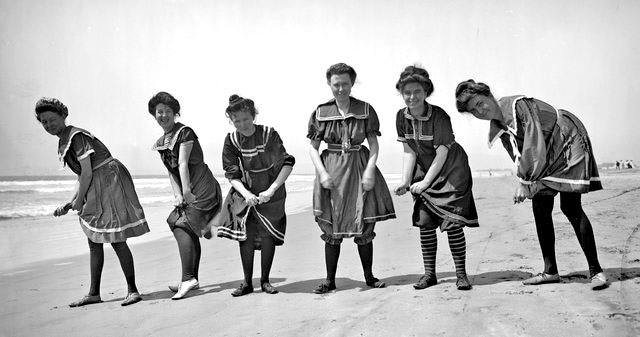The Evolution of Swimwear
Through decades and generations, values are constantly shifting and minds are opening. Social change is always slow, especially when it comes to discrimination of women because of their gender. Whether the argument was about a woman’s right to vote, work, or make her own decisions, these topics were often considered highly controversial. One interesting topic that has evolved a great amount throughout the years, is that of the female swimsuit. Women are finally able to wear whatever type of swimming suit they wanted, yet we still see issues and conflicts surrounding a female’s choice of outfit for the beach.
In the 1800s, women's beachwear consisted of a long gown made out of a heavy fabrics such as wool and flannel to cover up their figure. These dresses were designed for walking along the beach or hanging your legs in the water, rather than swimming. In this time and era, a woman’s modesty was very important and meant that they had good values. These suits made it difficult to be recognized, as they were extremely loose and baggy. The primary purpose of a female’s swimwear at the time was to conceal a woman’s body.
Micheline Bernardini modeling the first bikini on 5 July 1946 at the Piscine Molitor in Paris
In 1907 swimmer Annette Kellermann was arrested for wearing one piece swimsuit , afterwards, she marketed her own line & revolutionized womens swimwear
Women wearing turkish-style bloomers made of flannel at the beach in the 1900s.
In 1907, an iconic character made history with the first monumental progress in female swimwear fashion. Australian professional swimmer, Annette Kellermann, actively fought for the right for women to wear fitted one-piece bathing suits in public. On Revere Beach of Massachusetts, Kellermann was even arrested for wearing her tight one-piece swimwear, because it openly revealed her figure, even though was long- sleeved and did not show any skin. It was after this event that the popularity of this type of suit began to grow and we began to take our first steps towards modern bathing suits. In the year of 1916, the swimwear brand Jantzen released its first collection of swimwear that was fitted and short-sleeved, with cutouts. The company justified its “revealing” style with being for swimming and athletic purposes only. With that, women began showing more skin by ditching sleeves and wearing even shorter shorts. However, they would be fined and even arrested for wearing suits that did not have the permitted length.
For the first time. It was advertised and marketed as a two-piece swimsuit that “revealed everything about a girl except her mother’s maiden name.” Despite backlash and criticism, the trend continued to grow. As stretchy synthetic fabrics and nylon became more popular and readily available, swimwear became even tighter and women chose to show even more skin on a hot sunny day at the beach. Several iconic swim styles started to take over the generation, like the tight, red one-piece worn by Pamela Anderson and Carmen Electra in the famous film Baywatch.
As time went on, the majority of women across the world started wearing whatever outfit they wanted at the swimming pool or the beach. However, just when we thought we have achieved the freedom to choose our outfits in the summer, we are yet again confronted with another obstacle. In 2016, the so-called "burkini" was banned in several towns in France. A burkini is a type of swimsuit that is designed like a Burka, which is a garment that is worn in some Islamic traditions that conceals a woman’s body and hair. French Prime Minister Manuel Valls stated that it did not fit with the French values and this type of clothing “represented the enslavement of women”. Therefore, women wearing a burkini or a hijab (a headscarf that covers the hair), or even a long-sleeved swimsuit, would be fined for “not respecting the new dress code”. Several memes appeared across the internet that compared the current French policy about women’s swimwear to the early 1900s, when women were fined and arrested for wearing outfits that were shorter than allowed.
This all comes down to the conclusion that, as women, we have not yet completely achieved the freedom of speech and action. It is clear we have made lots of positive progress, where women used to be forced to wear full-length gowns and now are allowed to wear tight two-piece outfits, if they choose. However it is essential to note that a woman should be entitled to do as she pleases; if she wants to wear long-sleeve swimwear that covers her arms and head, she should be able to make that choice.
We should see the past positive achievements as a motivation to continue to advocate for the freedom of our decisions. We shall continue to fight for the right of women to wear whatever she wants and not be criticised nor judged for her choice of outfit.
Now, let’s get summer ready, wear your best outfit to the beach. You do you!
Pamela Anderson and Carmen Electra in Baywatch (TV Series 1989-2001)










